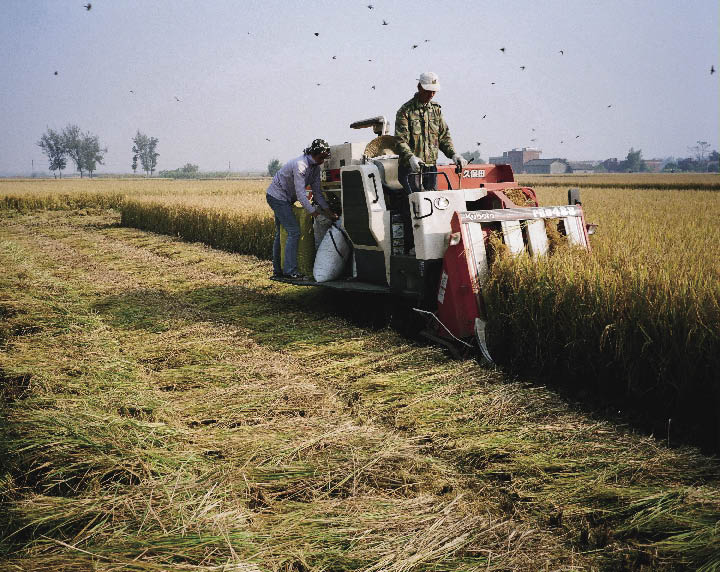| Guangxi:
Six Agricultural Pillar Industries
Support Income Rises for Farmers
By YI FAN
 |
| Bringing in the grain harvest |
THE government of Guangxi Zhuang Autonomous Region has achieved remarkable results by developing local agricultural industry. In particular they have increased grain production in recent years, and the annual income of farmers has increased by an average of 10 percent. At present, the planting area of sugarcane, cassava and spice, and the output of sugar and silkworm cocoons, all rank first in China. Fruits and vegetable yields are among the country's highest.
Located in China's southwest coastal area facing Southeast Asia, Guangxi is the only part of the PRC connected with ASEAN (the Association of Southeast Asia Nations) by both seaways and land. With a subtropical monsoon climate, the crops in Guangxi are rich in variety.
Grain: Yields Increase Through Science and Technology
In recent years, Guangxi has earnestly implemented the agricultural preferential policies of the central government to ensure crop yields, and its planting area and gross output of rice rank third and seventh domestically. Since 2001, cost-saving plowing-free cultivation technology has been applied to 4.7 million hectares of rice, corn and potato fields, generating an extra yield of 1.2 million tons and profit of RMB 4.3 billion for farmers. Since 2006, super rice has replaced the old variety across more than 700,000 hectares, increasing production by 375 to 750 kilograms per hectare. The highest output record was 12,000 kilograms per hectare.
Sugarcane: Effective Cultivation
Guangxi is China's largest sugar cane grower and sugar producer. During the season of 2007-08, it planted 990,000 hectares of sugarcane, bringing a yield of 75.36 million tons, respectively 55.18 percent and 61.6 percent of the country's total. More than 90 percent of the sugarcane acreage was high-yield, high-sugar variety, with an average output of 76.05 tons per hectare, an increase of 32 percent over 2000. In the same period, Guangxi produced 9.41 million tons of sugar, accounting for 63.41 percent of China's total, and the sugarcane crop brought in a sweet sales income of RMB 21.1 billion for its 20 million farmers.
Vegetables: Growing Steadily
Besides meeting local needs, about 60 percent of Guangxi's vegetables are sold in other areas of China, making it one of the major vegetable supply bases for northern provinces. In 2007, the planting area and output of vegetables in Guangxi ranked seventh and eleventh in China respectively, and the mushroom yield became the second highest in the country. In 2008, the planting area of mushroom was 980,000 hectares, with an output of 21.23 million tons and a total production value of RMB 22 billion. They represent increases by 302,000 hectares, 6.564 million tons and RMB 8.92 billion respectively over 2000. The output value of vegetables in Guangxi was RMB 64,755 per hectare, and the average income from vegetables was RMB 433.1 per farmer.
Silkworms: Tiptop Output
Grasping the opportunity of western development, Guangxi has devoted great efforts to developing sericulture. In 2007, the output of silkworm cocoons was 205,200 tons, 5.95 times higher than 2000. This represents 28 percent and 20 percent of China's total production and global output respectively. There were 832,000 households in 85 counties engaged in silkworm raising. The total income and the income per household were RMB 3.459 billion and RMB 4,157 respectively, an increase of 108.4 percent and 32.81 percent over 2004. The fresh cocoons of 2008 were ranked the best in China, an honor Guangxi has held for four years.
|
